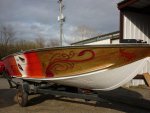As always sir, much much appreciated. The bus bars definitely makes sense now with that explanation. After a night of staring at the boat and trying to determine set up; I have a solution to my length issue... :facepalm:
(that's what she said)... cable length. I can fit one of the 6 gal gas tanks in the bow seating on the starboard side as the port side will have the amp mounted inside and that doesn't allow a tank. So i will keep the one tank in the back with both batteries and have the spare tank up front and just switch when needed. Gallon of gas weighs roughly 7+ lbs soooo 40 pounds is pretty manageable. Soo with that change I can keep the switch and bus bar in the stern.
One thing I'm not understanding is 2/0 gauge wire for the motor starter. Not exactly sure what is on the motor now but 2/0 seems very large and now at the run only being 6 feet rather than 15 prob overly excessive or am i missing something. I was think 2 awg but i feel i missing something here. 2AWG can handle 120amps at 0-15ft @ 3% voltage drop and 2/0AWG can pull 200amps at same distance. Now I know u should only load wire to 80% of its capacity; so 2/0= 160 amps and 2 AWG = 96 amps..... hmmmm THIS WOULD GO MUCH EASIER IF I WOULD JUST REMEMBER TO LOOK THROUGH MY OUTBOARD MANUAL!!

sorry i just keep forgetting to look.
The switch and the bus bar on the fuse block will be the longest run on the boat other than the amp to the bus bar for the stereo; both at 6-8 feet. So here goes my run down:
Stern light= 9 watts or 0.75 amps
Bow light= 7.5 watts or 0.625 amps
Bilge= 3 amps
LED interior rope lights (for near future)= 0.84 watts per foot @ 30ft just to be safe= 25.2 watts or 2.1 amps
Clarion Head unit= 50watts x 4 or 200 watts= 17 amps
12v accessory socket= im guessing draws whatever is plugged in sooo ??
Horn = 3 amps
TOTAL: 26.475 amps without whatever is plugged into 12v accessory socket
So with looking at the a chart.. the appropriate wire gauge would be 6-8AWG... this correct?
Here is the chart I went by:
http://bluesea.com/files/resources/reference/20010_Rev.003-web.pdf




















